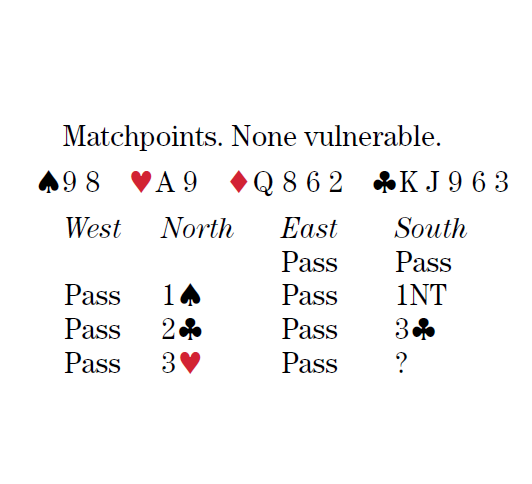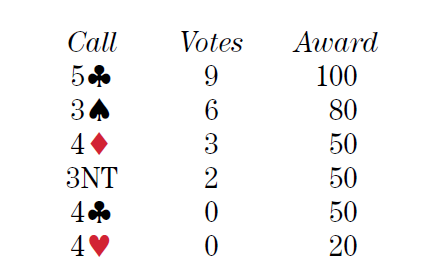
What’s your call?
| 3♠ | 3NT | |||
| 4♣ | 4♦ | 4♥ | 4♠ | 4NT |
| 5♣ | 5♦ | 5♥ | 5♠ | 5NT |
| 6♣ | 6♦ | 6♥ | 6♠ | 6NT |
| 7♣ | 7♦ | 7♥ | 7♠ | 7NT |
| Dbl | Pass |
Pattern patter
Partner has shown a 5=3=0=5 or a 5=3=1=4 pattern, or something like that, and a solid to maximum opening. Now, what do you do with that information?
“5♣,” says Robinson. “Because partner is short in diamonds, I don’t think we belong in 3NT. Opposite
♠A Q x x x ♥K x x ♦x ♣A Q x x,
5♣ is a very good contract.”
Boehm bids 5♣. “Diamonds are too weak for notrump facing shortness. 4♥ is apt to be interpreted as ‘to play,’ backing into a 5–3 fit.”
Walker, too, is worried about the diamond situation in notrump. “Even if ♦Q 8 6 2 stands up as a stopper, we might need two diamond stoppers to make 3NT.”
The Joyces go along with 5♣, even though “this might be a slight overbid.”
Cohen offers this analysis. “Without much wasted in diamonds, beautiful trump support and a side ace, I have a wonderful hand for partner. We could easily have a slam opposite perfect cards, but maybe we are already ahead of the game if we play 5♣ making six (beating the pairs in 3NT). This is not a weak fast-arrival jump; our side wasn’t yet committed to game. Partner is inviting game and I am accepting.”
The Gordons say they could have had a lot less for 3♣, even discounting the ♦Q. “It’s not right to bid 3♠ on a low doubleton. 3♠ should show honor-doubleton.”
Sanborn sees her options as 3NT, 3♠ or 4♠, 4♣ or 5♣, or 4♥. “I think that partner is pointing out short diamonds, so this may not be a good hand for play in 3NT. My cards should be working enough for a black-suit game, but jumping to 4♠ probably shows a spade honor instead of ♦Q. 4♣ is inadequate. 5♣ should be right. 4♥ could be misconstrued as a five-card suit and a place to play. I have a hard time constructing hands where 4♠ is a better contract than 5♣, so why offer it up with 3♠?”
Kennedy tells why: “I’ll let partner know I have a doubleton spade. 4♣ would be an underbid. Partner seems to be short in diamonds, so 3NT is out of the picture.”
The Sutherlins, too: “It’s time to let partner know we have two spades. There are many 17-point hands that partner can hold where 4♠ will make and score better than 5♣.”
Meyers temporizes with 3♠ as well. “Partner does not guarantee a fourth club. If I knew partner had two diamonds, I would bid 3NT. I am hoping that with ♦J x, partner will.”
Colchamiro bids 4♦ to ask partner to choose between 4♠ and 5♣. “Do I have to say that 4♦ can’t be natural? If partner punts back with 4♥, I’ll give him 4♠. With as little as:
♠A K J x x ♥K x x ♦x ♣A x x x,
we should be okay.”
Weinstein and Falk use 4♦ to investigate slam.
“4♦ is the only way to make a slam try, and my hand got very good,” says Weinstein. “4♥ would be an offer to play, and there are plenty of hands where slam is excellent. This hand is worth more than 5♣.”
“4♦ — time for a ‘Bluhmer,’” says Falk. “Named for the late Lou Bluhm, a Bluhmer is an ‘impossible’ bid by a limited hand that proclaims, ‘Partner, I’ve got a hand for you that might be a perfecto.’ I can’t tell if partner is testing to see how good my diamonds are, or whether he is actually void in diamonds with almost a jump shift, in which case we may have a club slam rather than just game.”
Hampson thinks that at matchpoints, bidding 3NT is clear. “Although there is still some slam potential, I expect ♦Q 8 6 2 facing a presumed small-ish singleton to be worth a stopper when in the closed hand.”

